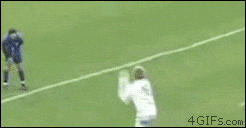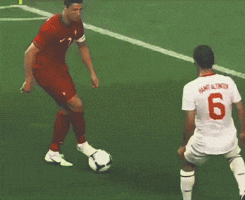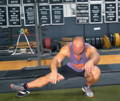Soccer Workouts To Strengthen Your Game
Some of the biggest issues that we have come across when training soccer players deals with coaches who are still stuck in the past. They are telling their athletes not to lift weights, fearing the players will get bulky, big, and showing up on the pitch looking like a bodybuilder. This is a big misconception.

Soccer coaches that are shying away from resistance-based training and strength training are missing out. Going into the weightroom does not mean training like a bodybuilder. That isn’t the case. In the weight room, soccer athletes can perform resistance training that will make them faster, more explosive, a little bit stronger, and enhance their capabilities on the field.
If you are new to strength training, whether you play soccer, field hockey, lacrosse, or another field based sport, the following principals will apply for your resistance based training.

1. Speed
The first element behind becoming a dominant player is to have excellent speed. Soccer athletes have to be fast. This boils down to what phase of running athletes will be utilizing within the sport. For instance, on the soccer field, how often are athletes running at absolute, full speed? How often are they having to go from a full stop to a full start into acceleration? How often are they coming out of acceleration and having to gear shift into a drive phase through a cut?
Soccer players typically are going to be starting and stopping and working through acceleration. It is very minimal when soccer players are running full tilt or running at the maximal mechanics phase. This means we need soccer players to be training with a focus on improving the starting positions and acceleration. This might mean we are working on various cuts, jump cuts, starting positions from a unilateral and bilateral perspective, and any other body positional needs that will transfer to the direct speed needed out on the soccer field.
2. DTC For Cutting
Dynamic Trunk Control, or DTC, is the ability to coordinate the trunk to stay vertical, upright, and rigid while the legs, hips, glutes, quads, and hamstrings are doing agile movements at a high speed with forceful production in and out of cuts. From a soccer perspective, we want to think of an athlete who can make better moves through dynamic trunk control. Dynamic trunk control allows the body to add stealth to agility. It creates the ability to create advantageous positions through footwork, putting opponents in precarious positions to be dominated.

For instance, we can work dynamic trunk control in the weight room in multiple ways. Examples include snatching, dumbbell snatching, plate overhead walking lunges, or skipping with a very light barbell overhead. We can also do sliding ab movements, a walrus, or other movements like that to train dynamic trunk control to help athletes become more agile out on the soccer field to make better moves and dominate opponents.
3. High-Speed Coordination
What does this mean? We can think of HSC in a plethora of ways. From a gymnastics perspective, we see elite gymnasts do flips with multiple twists. Or a shot-putter rotating and launching a sphere great distances; a weightlifter hitting a huge snatch. These are all examples of HSC.
But is that the type of HSC needed for soccer?

Yes, these movements can transfer well, but what we are talking about is a soccer player running at full speed having coordination with their footwork. Soccer does involve the soccer ball. Soccer players have to be able to run quickly with a ball. Compare this to ice hockey. Speed skaters are fast on the ice, but what is their coordination like with a puck?
Having speed is a must. We just need to understand that within the sport, there are specific demands that require an element of coordination, thus the HSC is necessary to handle the object within the athleticism.
We can do agility drills with a soccer ball. We can do cutting drills with a soccer ball. We can even do plyometrics followed by technical skill work to help the body become more explosive, more capable of rapidly coordinating while still training the skills to become an elite, world-class soccer player.
4. Strength Endurance
Soccer is a game that can last longer than ninety minutes. The game takes place over a long period of time. There is a lot of starting and stopping over that duration. Soccer players have to have strength endurance to help prevent injury.
Strength endurance can be trained in the weight room. It can also be trained on the soccer field while out doing technical work. Think about 800 m runners. They are really, really fast. Extremely fast. They also have really solid strength endurance. Soccer players might benefit from training in manners that are similar to the way 800 m runners train. For instance, some of the stuff we can do for soccer in the weight room that is similar is doing single-leg squats with lighter weight for sets of fifteen to twenty reps to be under stress for a longer period of time. We can even do sled pushes for time frames of five minutes. We can even do long-duration isometrics. All of these movements will drastically increase strength endurance.
Positional Comparison
Strength coaches often lack the understanding of the game of soccer to figure out how to train specific positions to optimize athletic performance. We need to train positions in a manner that exemplifies the skills required on the pitch from that position.

United States strength coaches do tend to know football pretty well. For instance, we see parallels between training soccer forwards in a manner similar to wide receivers. Training mid-fielders in a manner similar to defensive safeties--we want people with great ground coverage, crazy lateral speed, extremely athletic, good endurance, and really fast. We can train defensive soccer players similar to outside linebackers--still need to be fast, but a bit more a bruiser, more aggressive, and tremendously explosive. Goalies are similar to inside linebackers--goalies have a lot of lateral movement and a lot of lateral movement that leads to moving forward; they also have to be extremely explosive with incredibly fast reactions.
As strength coaches, we have to understand when to put the four elements into play. We have to know in our periodization when we will be focusing on speed and how we can focus on DTC in tandem. At the same time, we have to manage when to focus on HSC and strength endurance to create soccer players that demonstrate explosive, aggressive, and fast movements throughout the game, not having them tiring out late in the game.
We don’t need to run soccer players into the ground. We can look at other sports and use them as examples to teach athletes how to be more explosive while still maintaining strength endurance.
Lower Body Exercises
It is incredibly important to lift weights to improve lower body strength for soccer. Athletes who are more explosive and more coordinated can accelerate quicker and get out of cuts faster. Athletes who are lifting consistently in other sports like Rugby, American Football, are freakishly fast and agile.
These are the most important lower body exercises to develop leg strength for soccer.
1. Clean
Soccer players out on the pitch who want to dominate need to do full cleans for multiple different reasons. DTC (dynamic trunk control) is imperative to being agile on the soccer field, just as the ability to accelerate and be explosive out of cuts. Full cleans address all of these issues.
One reason why we love full cleans for soccer players is because athletes tend to be extremely weak in the full range of motion. This weakness leads to ankle injuries, knee problems, and lower back pain. If we can get soccer players to go in and complete full cleans for four or five sets of three to five reps, real simple sets and reps, will improve their explosiveness. They will make good hip extension, have an explosive finish, absorbing force in the full clean through a full range of motion, improving the strength of the lower back as well as the dorsiflexion of the ankle. Improved dorsiflexion goes a long way to improving steeper cuts and benefits acceleration because the knee tracts forward more out of specific cuts.
This can be done once or twice a week. We recommend starting with doing the movement twice a week. One day go heavy and the second day work on technique and speed out of the bottom position.
2. Single-Leg Squat
This movement incorporates the XTP machine. A great and tremendous piece of gym equipment that we love to incorporate into athletes’ workouts to improve their strength. Think of the XTP machine like a Smith Machine on steroids. The XTP is so much cooler.
The reason why we love using this machine is it makes it easier to put a larger load on the bar while doing higher reps. We need to remember that when talking about soccer, a key concept is strength endurance.
When we think about speed-based training, it is important to do unilateral work, especially when targeting the glutes, quads, and hamstrings. The XPT, a versatile piece of equipment when doing unilateral work, makes it nice and easy.
The single-leg squat for two to three sets of five to ten reps on each leg does wonders for unilateral strength. The movement helps to address instabilities and greatly strengthens the weaker side. Unilateral movements help minimize asymmetries that occur with coordinating the muscles in the body.

Now if the XPT is unavailable, we can still perform the single-leg squat by putting the back leg up on the back of a bench and perform the movement in a squat rack.
3. Overhead Walking Lunges
This is another movement that we have soccer players do to target DTC. We can target DTC with unilateral strength, mobility, and strength endurance.

With the arms extended and a plate held overhead, we can have soccer players perform three sets of sixteen to twenty alternating reps of walking lunges. The walking lunge can be performed walking forward or backward or a combination of both. We want to focus on squeezing the trunk, obliques, and upper back to coincide with all the muscles throughout the body. The overhead plate, especially walking backward, forces more stability and awareness of the body’s position. The DTC developed will lead to greater speed. In addition, the large sets do wonders for strength endurance development.
4. Sliding Cossack Squat
Sliding Cossack squats can be done using furniture sliders, a towel, or socks on a slippery surface. If these methods are unavailable, normal Cossack squats will suffice.
We like to have our athletes put the heel on the slider with the foot’s toes pointing up. We want to squeeze in the groin and get nice and deep in the squat. We also want to try and keep the heel of the squatting leg down on the ground. We want to do both sides as well. Perform three to four sets of seven reps on each leg.

The reason why we love this movement is that it does a great job of mobilizing the hips and ankles. If we can plant and track our knee forward over the toes, we can accelerate out of a cut quicker.
If we are training multi-plane, we will get stronger, become more mobile, and have a greater capacity for more powerful acceleration out of a cut.


Recap
Hammer full cleans for some great bilateral work that develops strength. Use the single-leg squat to develop unilateral strength and explosiveness. From there, the overhead walking lunges super-setted with sliding Cossack squats will develop strength endurance as well as enhance mobility for superior capabilities to accelerate out of cuts. The best part is the lower body exercises we are championing are training for multi-plane athletic performance--we need to go in the directions of X, Y, and Z, not just straight, not just to the side, and not just up in the air, but diagonal, side-to-side, in-and-out of cuts, and various changes of direction.
Implement these four exercises into a workout for lower body strength training and let us know how it goes.
DANE MILLER
Dane Miller is the owner and founder of Garage Strength Sports Performance. He works with a select handful of clients on building comprehensive programs for fitness and nutrition. Several times a year he leads a workshop for coaches, trainers, and fitness enthusiasts.



